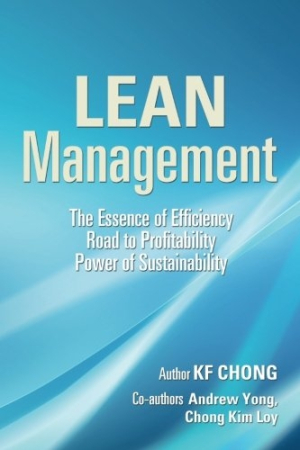Lean Management
The Essence of Efficiency, Road to Profitability, Power of Sustainability
Encompassing both practical advice and theoretical overviews, Lean Management is a helpful guide for making businesses more efficient, profitable, and valuable.
K. F. Chong’s Lean Management is an authoritative and enlightening guide to incrementally reducing workplace waste.
Drawing on a process first popularized by Toyota, the book details how businesses can improve efficiency, productivity, and quality through an approach of continuous improvement. Written to be accessible, it could serve as an introduction to the lean management philosophy, but it is also rich and erudite enough to teach even the most seasoned lean management expert something new and helpful.
The book does an exemplary job of explaining its core concept, from its origins to its implementation. Its focus is practical, drawing from many case studies and from the author’s experience at multinational corporations. Charts, photos, and other visual aids add further clarity, illustrating complex and technical concepts in an efficient and relatable way—for example, breaking a one-hour flight into its individual steps to distinguish which steps add value and which do not.
Lean Management also makes a compelling case for implementing such practices, stressing how much they reduce operating expenses and improve the bottom line. It backs up its claims with actual numbers and spells out highly rational arguments for how the concept makes businesses more competitive, less dependent on individual performance, less prone to miscommunication, and more like a finely tuned motor.
Thorough research is evident, but more references and greater detail are sometimes desired, as when it asserts that Toyota was at one point more profitable than Ford, General Motors, and Chrysler combined. The overabundance of jargon may hold outsiders at a distance.
The book is well organized, progressing logically and gradually introducing more and more sophisticated concepts. Entire chapters are devoted to ideas like the Kaizen concept of continuous improvement; just-in-time manufacturing, which is set up to immediately install all component parts without stockpiling or waste; and the statistical method ANOVA, which analyzes variance. The explorations make it handy as a reference book.
Evenhanded and thorough, the book also helpfully dissects some ideas. For example, it explores both the practical pros and cons of ideas like Jidoka, or the deployment of automation to replace repetitive manual labor that often proves prone to human error. Instead of just promoting the concept, the useful guide takes a more realistic tack, cautioning that Jidoka implementation can be counterproductive if the machines used are not reliable.
Encompassing both practical advice and theoretical overviews, Lean Management is a helpful guide for making businesses more efficient, profitable, and valuable.
Reviewed by
Joseph S. Pete
Disclosure: This article is not an endorsement, but a review. The publisher of this book provided free copies of the book and paid a small fee to have their book reviewed by a professional reviewer. Foreword Reviews and Clarion Reviews make no guarantee that the publisher will receive a positive review. Foreword Magazine, Inc. is disclosing this in accordance with the Federal Trade Commission’s 16 CFR, Part 255.

